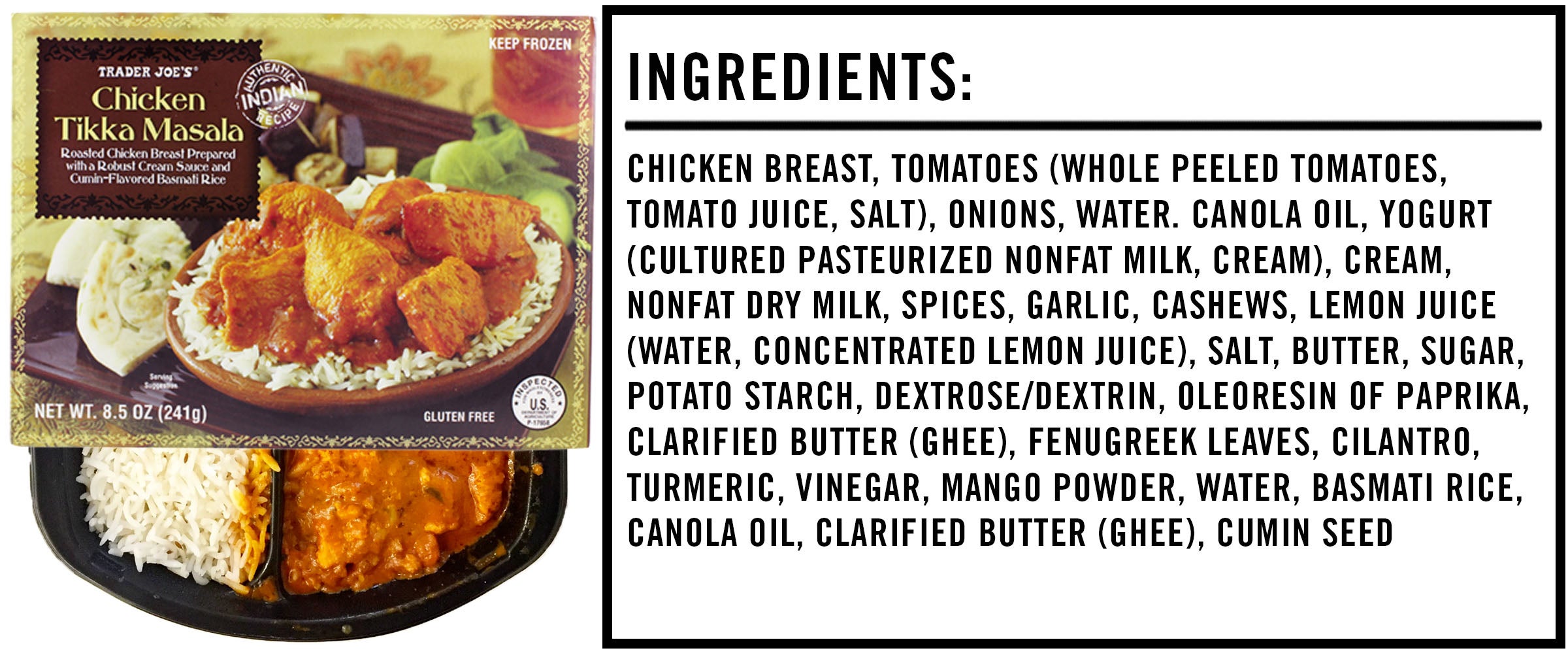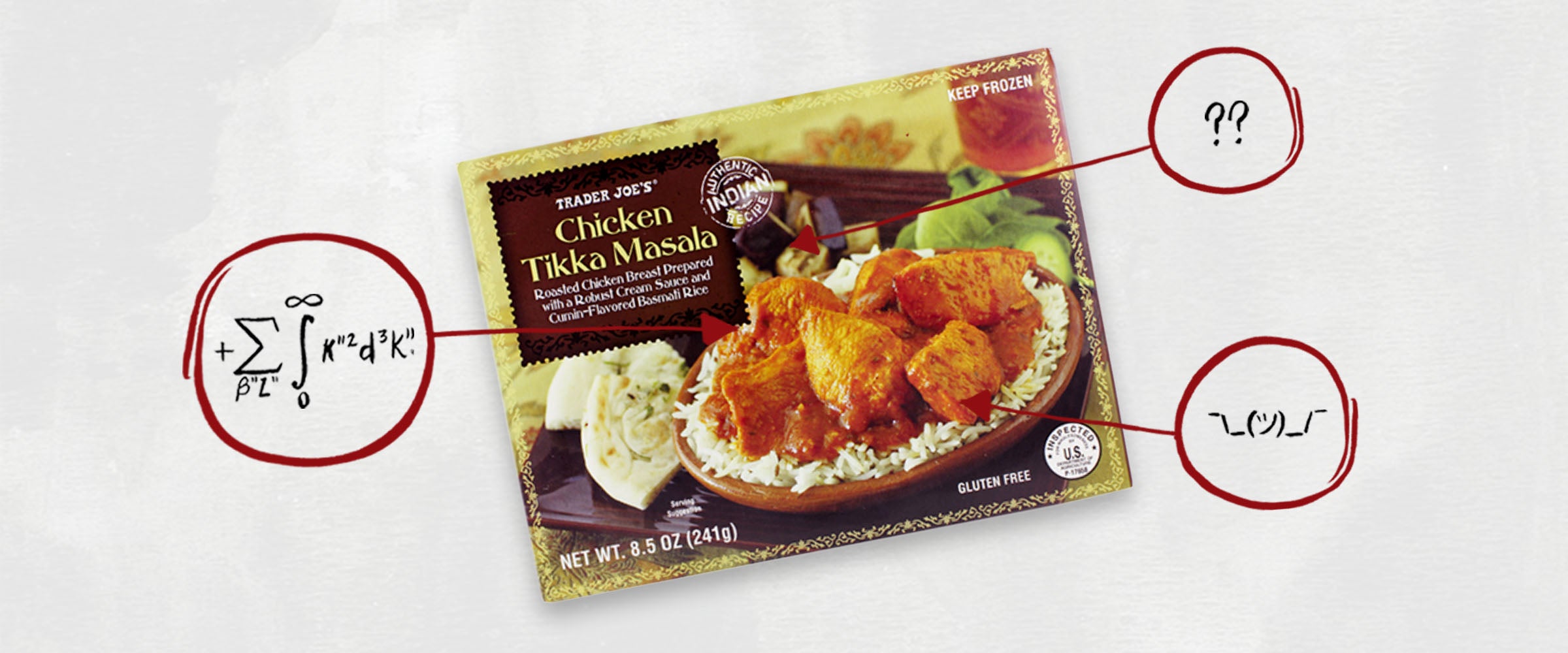We’re often told that you should never eat anything (or put anything on your body) if you don’t recognize everything on the ingredients list. But since most of us have no idea what xanthan gum or potassium benzoate are — or more importantly, what they’re doing to our bodies — we’re decoding the ingredients in the many things Americans put in (and on, or near) themselves with the help of an expert.
This edition: Trader Joe’s Chicken Tikka Masala, which is made from 29 separate ingredients that we’ve broken down in the exact order they appear online.

The Ingredients
The Chicken Tikka
1) Chicken Breast: Despite established evidence suggesting white meat, like chicken, is healthier than red meat, like steak, some more recent research suggests that both are equally dangerous and capable of wrecking your heart. Shit!
2) Tomatoes (Whole Peeled Tomatoes, Tomato Juice and Salt): These red juicy bois contain loads of lycopene, an antioxidant linked to many health benefits, including reduced risk of heart disease and cancer.
3) Onions: Onions support your digestive system — research shows those who consume onions and other allium vegetables, like scallions, garlic, leeks, shallots and chives, have a lower risk of stomach, colon and prostate cancer. Nice!
4) Water: My eyes produce this when I think about all the terrible ingredients I’ve come across while writing this column.
5) Canola Oil: Physician and biochemist Cate Shanahan, author of Deep Nutrition: Why Your Genes Need Traditional Food, previously told me that consuming too much vegetable oil (canola, sunflower or corn) — which is easy to do, considering Shanahan says roughly 45 percent of the average American’s calories come from refined oils — has serious repercussions (fatty liver disease, insulin resistance and migraines). While it’s nearly impossible to eliminate vegetable oil from your diet altogether — major contributors include processed foods, fried foods, frozen pizzas, cakes, cookies, margarines and coffee creamers — it’s best consumed in moderation.
6) Yogurt (Cultured Pasteurized Nonfat Milk, Cream): This is what makes the masala sauce creamy. Unfortunately, cream — one of the main ingredients — is high in saturated fat, which has long been associated with heart disease (there are, however, more recent studies that suggest saturated fat is less harmful than we once thought, which is good news).
7) Cream: Cream is a thick layer of fat that rises to the top of milk before it undergoes homogenization, a process that breaks down the fat molecules in milk to prevent them from separating. Despite tasting awesome, again, cream contains a whole load of potentially unhealthy fat.
8) Nonfat Dry Milk: Nonfat dry milk (i.e., powdered milk) is just pasteurized skim milk that has had all of the water removed. This provides protein and adds some bulk to the masala sauce.
9) Spices: What these spices are remains a mystery, because as we learned in our exploration of the ingredients in nacho-flavored Doritos, the FDA doesn’t require food labelers to list each spice by their specific name (as a means of protecting their recipes) so long as it follows their definition of the word spice:
“The term spice means any aromatic vegetable substance in the whole, broken or ground form, except for those substances which have been traditionally regarded as foods, such as onions, garlic and celery; whose significant function in food is seasoning rather than nutritional; that is true to name; and from which no portion of any volatile oil or other flavoring principle has been removed.”
10) Garlic: Garlic earned the number one spot on our recent ranking of spices, since this ultra-fragrant dude supports your immune system, bolsters your heart and provides a nice assortment of vitamins and minerals.
11) Cashews: Like garlic, these nuts are also good for your heart — a study published in the Journal of Nutrition shows cashews may help reduce blood pressure and raise “good” cholesterol levels.
12) Lemon Juice (Water and Concentrated Lemon Juice): This provides a hint of citrus and might act as a mild preservative.
13) Salt: This enhances the overall flavor. The good news is, unlike some other processed foods, this chicken tikka masala only contains 580 milligrams of sodium, which is an okay amount. The American Heart Association recommends consuming no more than 2,300 milligrams per day, and in an ideal world, they say that most adults should have no more than 1,500 milligrams — so 580 milligrams in one meal should keep you within those recommendations.
14) Butter: Similar to cream, butter boasts tons of unhealthy fats, so it should be enjoyed in moderation.
15) Sugar: There are six grams of sugar in this frozen chicken tikka masala, which is a perfectly fine amount — the American Heart Association recommends men consume no more than 36 grams and women consume no more than 25 grams a day.
16) Potato Starch: A starch extracted from — you guessed right — potatoes often used as a thickener. In other words, this helps give the masala sauce a thick texture.
17) Dextrose (or Dextrin): Dextrose is a sugar derived from starches, like corn. Fun fact: Dextrose has a high glycemic index, meaning it quickly raises blood sugar levels, so it’s used in IV solutions to treat low blood sugar and dehydration. People with diabetes might also consume dextrose tablets to raise their blood sugar if they become dangerously low. Because of this blood-sugar-boosting effect, consuming dextrose can also provide an almost immediate jolt of energy — followed by an inevitable crash.
Dextrin, meanwhile, is a broad term referring to several different carbohydrate strains that are produced by the hydrolysis of starch, meaning water has been used to break down the molecules into smaller molecules. In the case of this chicken tikka masala, dextrin is probably used as another thickening agent. As for what dextrin does to your body, mostly good things, actually — one study shows it provides soluble fiber that can reduce cholesterol levels, boost immune function, improve mineral absorption and help reduce excess body fat.
18) Oleoresin of Paprika: Oleoresin of paprika is an oil-soluble extract from the capsicum annuum or capsicum frutescens fruits. It adds to the reddish color of the masala sauce.
19) Clarified Butter (Ghee): Used in many Middle Eastern dishes, ghee is made by heating butter until the milk solids can be strained away, leaving behind liquid fat. While the lack of milk solids might be better for those with lactose intolerance, despite some rumors suggesting ghee is healthier than regular butter, little research exists to back that up.
20) Fenugreek Leaves: This herb has a somewhat nutty flavor and can lower blood sugar levels.
21) Cilantro: Cilantro has the capacity to remove dangerous heavy metals from the body that could otherwise result in heart disease, hormonal imbalances, neurological conditions and infertility.
22) Turmeric: Turmeric boasts a powerful antioxidant called curcumin, which has been shown to reduce levels of inflammation in the body.
23) Vinegar: This adds some bitterness to balance out the sweetness and cut through the fat.
24) Mango Powder: Besides containing some powerful antioxidants, mango powder might also add to the color of this masala sauce.
The Cumin Rice
1) Water: As you may well know, water is essential to making rice.
2) Basmati Rice: Basmati rice is a good source of niacin and thiamine, two nutrients that support a healthy nervous system and combat depression and memory loss. In other words, basmati rice is exactly what I need right now… wait, where am I, and why am I so damn sad?
3) Canola Oil: Again, consume this stuff in moderation.
4) Clarified Butter (Ghee): You already know this one!
5) Cumin Seeds: Cumin seeds contain a whole bunch of plant compounds that have been shown to improve brain function, boost your immune system and even help prevent diabetes and fight cancer.
The Takeaway
Honestly, this is some pretty good stuff, especially compared to many other frozen meals. Sure, it contains a decent amount of fat — 14 grams, to be exact — but when you consider the recommended amount per 2,000-calorie day is a generous 67 grams, that number seems perfectly okay. Otherwise, most of the ingredients are pretty damn healthy.
The biggest issue I see with this chicken tikka masala is the fact that one container is only 360 calories. That might sound like a good thing, but when you find yourself still hungry 20 minutes after heating up this frozen meal, you might be inclined to (1) heat up another portion and double up on those fats; or (2) eat everything in your pantry, including that monstrous bucket of peanut butter cups.
However, if you can control your hunger — and maybe serve it with a side of vegetables to make it a more satiating meal — this chicken tikka masala can make a perfectly fine substitute when you don’t have time to cook.

